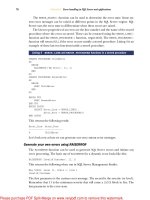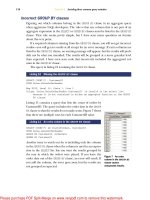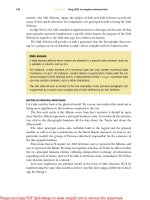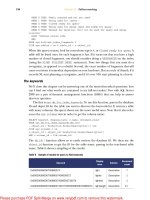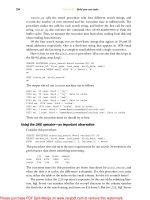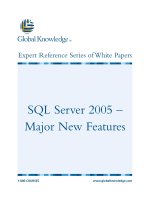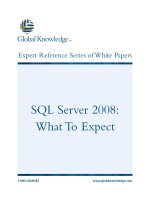Tài liệu SQL Server MVP Deep Dives- P21 pptx
Bạn đang xem bản rút gọn của tài liệu. Xem và tải ngay bản đầy đủ của tài liệu tại đây (1.7 MB, 40 trang )
754
C
HAPTER
59
Incremental loads using T-SQL and SSIS
SQL
Server 2008 are the Change Tracking and Change Data Capture fea-
tures which, as their names imply, automatically track which rows have
been changed, making selecting from the source database much easier.
Now that we’ve looked at an incremental load using
T-SQL
, let’s consider how
SQL
Server Integration Services can accomplish the same task without all the hand-coding.
Incremental loads in SSIS
SQL
Server Integration Services (
SSIS
) is Microsoft’s application bundled with
SQL
Server that simplifies data integration and transformations—and in this case, incre-
mental loads. For this example, we’ll use
SSIS
to execute the lookup transformation
(for the join functionality) combined with the conditional split (for the
WHERE
clause
conditions) transformations.
Before we begin, let’s reset our database tables to their original state using the
T-SQL
code in listing 8.
USE SSISIncrementalLoad_Source
GO
TRUNCATE TABLE dbo.tblSource
INSERT INTO dbo.tblSource
(ColID,ColA,ColB,ColC)
VALUES(0, 'A', '1/1/2007 12:01 AM', -1)
-- insert a "changed" row
INSERT INTO dbo.tblSource
(ColID,ColA,ColB,ColC)
VALUES(1, 'B', '1/1/2007 12:02 AM', -2)
INSERT INTO dbo.tblSource
(ColID,ColA,ColB,ColC)
VALUES(2, 'N', '1/1/2007 12:03 AM', -3)
USE SSISIncrementalLoad_Dest
GO
TRUNCATE TABLE dbo.tblDest
INSERT INTO dbo.tblDest
(ColID,ColA,ColB,ColC)
VALUES(0, 'A', '1/1/2007 12:01 AM', -1)
INSERT INTO dbo.tblDest
(ColID,ColA,ColB,ColC)
VALUES(1, 'C', '1/1/2007 12:02 AM', -2)
With the tables back in their original state, we’ll create a new project using Business
Intelligence Development Studio (
BIDS
).
Creating the new BIDS project
To follow along with this example, first open
BIDS
and create a new project. We’ll
name the project SSISIncrementalLoad, as shown in figure 1. Once the project loads,
open Solution Explorer, right-click the package, and rename Package1.dtsx to SSISIn-
crementalLoad.dtsx.
Listing 8 Resetting the tables
Insert unchanged row
Insert changed row
Insert new row
Insert unchanged row
Insert changed row
Licensed to Kerri Ross <>
Please purchase PDF Split-Merge on www.verypdf.com to remove this watermark.
755
Incremental loads in SSIS
When prompted to rename the package object, click the Yes button. From here, fol-
low this straightforward series:
1
From the toolbox, drag a data flow onto the Control Flow canvas. Double-click
the data flow task to edit it.
2
From the toolbox, drag and drop an
OLE
DB
source onto the Data Flow canvas.
Double-click the
OLE
DB
Source connection adapter to edit it.
3
Click the New button beside the
OLE
DB
Connection Manager drop-down.
Click the New button here to create a new data connection. Enter or select your
server name. Connect to the SSISIncrementalLoad_Source database you cre-
ated earlier. Click the
OK
button to return to the Connection Manager configu-
ration dialog box.
4
Click the
OK
button to accept your newly created data connection as the con-
nection manager you want to define. Select dbo.tblSource from the Table
drop-down.
5
Click the
OK
button to complete defining the
OLE
DB
source adapter.
Defining the lookup transformation
Now that the source adapter is defined, let’s move on to the lookup transformation
that’ll join the data from our two tables. Again, there’s a standard series of steps in
SSIS
:
1
Drag and drop a lookup transformation from the toolbox onto the Data Flow
canvas.
Figure 1 Creating a new BIDS project named SSISIncrementalLoad
Licensed to Kerri Ross <>
Please purchase PDF Split-Merge on www.verypdf.com to remove this watermark.
756
C
HAPTER
59
Incremental loads using T-SQL and SSIS
2
Connect the
OLE
DB
connection adapter to the lookup transformation by click-
ing on the
OLE
DB
Source, dragging the green arrow over the lookup, and
dropping it.
3
Right-click the lookup transformation and click Edit (or double-click the
lookup transformation) to edit. You should now see something like the exam-
ple shown in figure 2.
When the editor opens, click the New button beside the
OLE
DB
Connection Manager
drop-down (as you did earlier for the
OLE
DB
source adapter). Define a new data con-
nection—this time to the SSISIncrementalLoad_Dest database. After setting up the
new data connection and connection manager, configure the lookup transformation
to connect to dbo.tblDest. Click the Columns tab. On the left side are the columns
currently in the
SSIS
data flow pipeline (from SSISIncrementalLoad_Source.
dbo.tblSource). On the right side are columns available from the lookup destination
you just configured (from SSISIncrementalLoad_Dest.dbo.tblDest).
We’ll need all the rows returned from the destination table, so check all the check
boxes beside the rows in the destination. We need these rows for our
WHERE
clauses
and our
JOIN
ON
clauses.
We don’t want to map all the rows between the source and destination—only the
columns named ColID between the database tables. The mappings drawn between
the Available Input columns and Available Lookup columns define the
JOIN
ON
clause.
Multi-select the mappings between ColA, ColB, and ColC by clicking on them while
holding the Ctrl key. Right-click any of them and click Delete Selected Mappings to
delete these columns from our
JOIN ON
clause, as shown in figure 3.
Figure 2 Using SSIS to edit the lookup transformation
Licensed to Kerri Ross <>
Please purchase PDF Split-Merge on www.verypdf.com to remove this watermark.
757
Incremental loads in SSIS
Add the text Dest_ to each column’s output alias. These rows are being appended to
the data flow pipeline. This is so that we can distinguish between source and destina-
tion rows farther down the pipeline.
Setting the lookup transformation behavior
Next we need to modify our lookup transformation behavior. By default, the lookup
operates similar to an
INNER
JOIN
—but we need a
LEFT
(
OUTER
)
JOIN
. Click the Con-
figure Error Output button to open the Configure Error Output screen. On the
Lookup Output row, change the Error column from Fail Component to Ignore Fail-
ure. This tells the lookup transformation that if it doesn’t find an
INNER
JOIN
match in
the destination table for the source table’s ColID value, it shouldn’t fail. This also
effectively tells the lookup to behave like a
LEFT
JOIN
instead of an
INNER
JOIN
. Click
OK
to complete the lookup transformation configuration.
From the toolbox, drag and drop a conditional split transformation onto the Data
Flow canvas. Connect the lookup to the conditional split as shown in figure 4. Right-
click the conditional split and click Edit to open the Conditional Split Transformation
Editor. The Editor is divided into three sections. The upper-left section contains a list
of available variables and columns. The upper-right section contains a list of available
operations you may perform on values in the conditional expression. The lower sec-
tion contains a list of the outputs you can define using
SSIS
Expression Language.
Figure 3 Using the Lookup Transformation Editor to establish the correct mappings
Licensed to Kerri Ross <>
Please purchase PDF Split-Merge on www.verypdf.com to remove this watermark.
758
C
HAPTER
59
Incremental loads using T-SQL and SSIS
Expand the
NULL
Functions folder in the upper-right section of the Conditional
Split Transformation Editor, and expand the Columns folder in the upper-left section.
Click in the Output Name column and enter
New Rows
as the name of the first output.
From the
NULL
Functions folder, drag and drop the
ISNULL(
<<expression>>
)
func-
tion to the Condition column of the New Rows condition. Next, drag Dest_ColID
from the Columns folder and drop it onto the <<expression>> text in the Condition col-
umn. New rows should now be defined by the condition
ISNULL(
[Dest_ColID]
)
.
This defines the
WHERE
clause for new rows—setting it to
WHERE
Dest_ColID
Is
NULL
.
Type
Changed
Rows
into a second output name column. Add the expression
(ColA
!= Dest_ColA)
||
(ColB
!=
Dest_ColB)
||
(ColC
!=
Dest_ColC)
to the Condition col-
umn for the Changed Rows output. This defines our
WHERE
clause for detecting
changed rows—setting it to
WHERE
((Dest_ColA
!=
ColA)
OR
(Dest_ColB
!=
ColB)
OR
(Dest_ColC
!=
ColC))
. Note that
||
is the expression for
OR
in
SSIS
expressions.
Change the default output name from Conditional Split Default Output to
Unchanged Rows.
It’s important to note here that the data flow task acts on rows. It can be used to
manipulate (transform, create, or delete) data in columns in a row, but the sources,
destinations, and transformations in the data flow task act on rows.
In a conditional split transformation, rows are sent to the output when the
SSIS
Expression Language condition for that output evaluates as true. A conditional split
transformation behaves like a
Switch
statement in
C#
or
Select
Case
in Visual Basic,
in that the rows are sent to the first output for which the condition evaluates as true.
This means that if two or more conditions are true for a given row, the row will be sent
to the first output in the list for which the condition is true, and that the row will never
be checked to see whether it meets the second condition. Click the
OK
button to com-
plete configuration of the conditional split transformation.
Drag and drop an
OLE
DB
destination connection adapter and an
OLE
DB
com-
mand transformation onto the Data Flow canvas. Click on the conditional split and
connect it to the
OLE
DB
destination. A dialog box will display prompting you to select
a conditional split output (those outputs you defined in the last step). Select the New
Rows output. Next connect the
OLE
DB
command transformation to the conditional
split’s Changed Rows output. Your Data Flow canvas should appear similar to the
example in figure 4.
Configure the
OLE
DB
destination by aiming at the SSISIncremental-
Load_Dest.dbo.tblDest table. Click the Mappings item in the list to the left. Make
sure the ColID, ColA, ColB, and ColC source columns are mapped to their matching
destination columns (aren’t you glad we prepended Dest_ to the destination col-
umns?). Click the
OK
button to complete configuring the
OLE
DB
destination con-
nection adapter. Double-click the
OLE
DB
command to open the Advanced Editor for
the
OLE
DB
Command dialog box. Set the Connection Manager column to your
SSISIncrementalLoad_Dest connection manager. Click on the Component Proper-
ties tab. Click the ellipsis (...) beside the SQLCommand property. The String Value
Licensed to Kerri Ross <>
Please purchase PDF Split-Merge on www.verypdf.com to remove this watermark.
759
Incremental loads in SSIS
Editor displays. Enter the following parameterized
T-SQL
statement into the String
Value text box:
UPDATE dbo.tblDest
SET
ColA = ?
,ColB = ?
,ColC = ?
WHERE ColID = ?
The question marks in the previous parameterized
T-SQL
statement map by ordinal to
columns named Param_0 through Param_3. Map them as shown here—effectively
altering the
UPDATE
statement for each row:
UPDATE SSISIncrementalLoad_Dest.dbo.tblDest
SET
ColA = SSISIncrementalLoad_Source.dbo.ColA
,ColB = SSISIncrementalLoad_Source.dbo.ColB
,ColC = SSISIncrementalLoad_Source.dbo.ColC
WHERE ColID = SSISIncrementalLoad_Source.dbo.ColID
As you can see in figure 5, the query is executed on a row-by-row basis. For perfor-
mance with large amounts of data, you’ll want to employ set-based updates instead.
Figure 4 The Data Flow canvas shows a graphical view of the transformation.
Licensed to Kerri Ross <>
Please purchase PDF Split-Merge on www.verypdf.com to remove this watermark.
760
C
HAPTER
59
Incremental loads using T-SQL and SSIS
Click the
OK
button when mapping is completed. If you execute the package with
debugging (press F5), the package should succeed.
Note that one row takes the New Rows output from the conditional split, and one
row takes the Changed Rows output from the conditional split transformation.
Although not visible, our third source row doesn't change, and would be sent to the
Unchanged Rows output—which is the default Conditional Split output renamed.
Any row that doesn’t meet any of the predefined conditions in the conditional split is
sent to the default output.
Summary
The incremental load design pattern is a powerful way to leverage the strengths of the
SSIS
2005 data flow task to transport data from a source to a destination. By using this
method, you only insert or update rows that are new or have changed.
Figure 5 The Advanced Editor shows a representation of the data flow prior to execution.
Licensed to Kerri Ross <>
Please purchase PDF Split-Merge on www.verypdf.com to remove this watermark.
761
Summary
About the author
Andy Leonard is an architect with Unisys corporation,
SQL
Server database and integration services developer,
SQL
Server
MVP
,
PASS
regional mentor (Southeast
US
), and engineer. He’s
a coauthor of several books on
SQL
Server topics. Andy
founded and manages VSTeamSystemCentral.com and main-
tains several blogs there—Applied Team System, Applied Data-
base Development, and Applied Business Intelligence—and
also blogs for SQLBlog.com. Andy’s background includes web
application architecture and development,
VB
, and
ASP
;
SQL
Server Integration Services (
SSIS
); data warehouse develop-
ment using
SQL
Server 2000, 2005, and 2008; and test-driven
database development.
Licensed to Kerri Ross <>
Please purchase PDF Split-Merge on www.verypdf.com to remove this watermark.
Licensed to Kerri Ross <>
Please purchase PDF Split-Merge on www.verypdf.com to remove this watermark.
763
A
abstraction
6
abstraction layer
7
access control lists
464
Access databases
715
access roles
298
Access. See Microsoft Access
Access/JET database
272
ACLs. See access control lists
ACS. See Audit Collection Ser-
vice
action groups
673
AUDIT_CHANGE_GROUP
673
DBCC_GROUP
673
SCHEMA_OBJECT
_CHANGE_GROUP
673
Action on Audit Failure
365
Action property
355
actions
621–623, 625, 673
binding
626
T-SQL stack
625
types
625
Active Directory
345, 498, 500,
517
configuring
503
domains
500–501, 503
Domains and Trust
502–503
forest
501, 503
requirements
503, 508
trees
501
User and Computers
504
Active Domain authentication
credentials
270
active queries
390
ActiveSync-connected
device
301
ad hoc full backup
447
ad hoc queries
399, 598, 600
largest
598
ad hoc reports
687
ad hoc SQL
7, 217, 554
ad hoc workloads
452
AddDevice method
355
administrative
considerations
258
ADO.NET
213, 227, 262,
264–267, 273, 299, 307,
346, 351
ADO.NET 2.0
259, 263, 274
ADO.NET 3.5
210, 226, 268
ADO .NET 3.5 SP1
210
code
210, 228
connection manager 715
conversions
227
data providers
302
data table
208
factory-based objects
228
factory-method-based
objects
227
objects
226
OLE DB data provider
663
provider
303
provider model
210
SqlClient data provider
272
ADO.NET Entity
Framework
210, 216, 219
Advanced Schedule
Options
468
AdventureWorks
30, 47, 87,
111, 178, 182, 185, 188,
541–542, 547, 585–586
SQL Server 2005
version
541
AdventureWorks2008
database
111–112, 177,
189, 201, 376, 646
AdventureWorksDW
database
235
AdventureWorksDW2008
691
AdventureWorksLT2008
database
225, 228, 230
ADW
aggregations
705
designing aggregations
702
query patterns
701
Specify Object Counts
703
AES
298
AFTER triggers
20, 558, 561
Age in Cache column
593
Age of Empires
269
Agent jobs
330–331, 338, 342
Agent schedule
331
Aggregate component.
See asynchronous compo-
nents
aggregate queries
601
aggregated levels
700
aggregation
candidates
702–703
aggregation design
700,
702–703, 705, 707
high-performance
cubes
708
index
Licensed to Kerri Ross <>
Please purchase PDF Split-Merge on www.verypdf.com to remove this watermark.
764
INDEX
aggregation design (continued)
influencing
702
partition level
707
Aggregation Design
Wizard
701
performance benefit
701
aggregation designs
other considerations
707
resource utilization
707
Aggregation Management
tool
707
Aggregation Manager
706
aggregations
247, 558, 639,
700
Aggregation Manager
706
Analysis Services
701
cache
700
comparing with
indexes
701
cost of designing
707
designing
701
disk space
707
fact table
708
influencing
702
leveraging
706–707
lower level
701
OLAP solution
701
partition level
701
partitions
707
Profiler
705
query log
705
target number
707
AggregationUsage
property
703
aggregators
743
agility
526
alerts
293, 455
low free disk space
521
algorithms
688
parameters
688
aliases
86, 92, 268
alloc_unit_type_desc
405
allocated area
245
allocation order scan
614
allocation unit
405
allocation unit type
386, 404
ALTER
179–181, 224
ALTER DATABASE
292, 454
ALTER INDEX
334–335
ALTER INDEX REBUILD
439
ALTER PARTITION
FUNCTION
418
ALTER TABLE
15, 408
Amazon.com
634
AMO. See Analysis Manage-
ment Objects
Analysis Management
Objects
353
Analysis Services
260, 636, 638,
645, 692, 700
ADW
701
aggregations
701
attribute relationships
704
candidate attributes for
aggregation
702
designing hierarchies
707
fact table
708
hierarchy types
708
leveraging aggregations
707
query log
705
user-defined hierarchy
704
Analysis Services 2005
703,
706
Aggregation Management
tool
707
Analysis Services 2005 cubes
aggregations
706
Analysis Services 2008
703
aggregations
706
core concept
704
usage-based
optimization
707
Analysis Services ADW
707
Analysis Services cubes
634,
637, 639
Analysis Services engine
UBO
706
Analysis Services UDM
cubes
698
anonymous rowsets
216, 218
anonymous types
213, 216,
218
ANSI SQL standards
217
ranking functions
217
windowing functions
217
ANSI standard
specification
45
windowing extensions
45
ApexSQL Audit
672
application architecture
276
application code
25
application connection
strings
461
See also connection strings
application data
359
application developers
25
application ecosystem
323
application integration
322,
326
Application Log
673, 675
Application Log Server
Audit
374
application profile
4
application server
222
application testing
460
application virtualization
519
ApplicationLog server
audit
372
appname
553
architects
6–7
architectural
considerations
258
architecture
298
archiving
322–323, 480
ARM
298
array index
122
arrays
221
artificial intelligence
688
ASCII format
662
ASP
263, 642, 654, 658
ASP applications
263
ASP.NET
509, 512
applications
263, 265,
267–268, 270–271, 273
service
270
ASP.NET site, average connec-
tions used
274
ASP-type application
263
connection
263
Assembly object
354
associated entities
216
Association Rules
690
associative database tables
170
associative entities
155, 163,
167, 169
asynchronous
457
audit
371
bucketizing target
625
components
745
database mirroring
462
file target
625
mode. See high-performance
mode
operations
265, 267
ring buffer target
625
targets
629
Attribute Discrimination
viewer
695
attribute relationships
704–705, 708
designing
705
attribute-by-attribute basis
31
attributes
153, 688
combinations of
dependencies
40
functional dependencies
28
functionally dependent
attributes
34
many-attribute relation
39
audit action groups
366,
372–373, 376, 379
audit actions
366
audit application
498
Audit Collection Service
370
Licensed to Kerri Ross <>
Please purchase PDF Split-Merge on www.verypdf.com to remove this watermark.
765
INDEX
audit events
365–366,
370–371, 374
viewing
374
audit files
371, 374
audit folder
374
Audit GUID
367, 371
audit information
674
audit infrastructure
365
audit log
498
audit name
369
audit objects
365, 372
audit output types
366
Audit Policy
367
audit records
673
audit row
674
audit specifications
366, 676
audited events
673
auditing
322, 365, 381, 394,
671, 673
database level
365
DDL statements
365
DML events
376
filtering
378
filters
376
instance level
365, 372
auditing activity
675
information
469
audits
350, 673
authentication
269
credentials
270
methods
384, 510
protocol
498
Auto Close
559
auto create statistics
564
AUTO option
179
Auto Shrink
559
auto update statistics
564
Auto_Open
665
AutoComplete
382
automated job
468
automatic data protection
12
automatic failover
449–451,
457, 461–462
automatic range
management
478
automatic redundancy
462
Automatically Detect Settings
option
506
automation engine
344, 347
auto-parameterization
211–212
Auto-Regression Trees
691
Auto-Regressive Integrated
Moving Average
691
auxiliary table
283
average page density
617
average page space
404
average reads
398
average seek time
607–609,
611
average worker time
594
axis step
120
B
backup compression
452–453,
461
native backup
compression
453
BACKUP DATABASE
384,
436
backup database
331–332,
338
backup device
339
backup drives
451
backup file name
356
backup files
451, 453
removal
331
backup history
331
Backup object
355
backup routine
451
backup script
465
backup strategy
356
backup type
338
BackupDeviceItem
358
BackupDevices
350
BackupDirectory
property
355
backups
322, 326–327, 330,
355–356, 432, 450–451,
461, 518
backup files
355
backup sizes
432
backup time
432
compressing
432
disaster recovery
testing
358
eliminating index data
432,
447
energy consumption
432
energy-efficient
432
filegroup backups
432
frequency
467
full backup
453, 454
full database backups
433,
435
restoration
433, 447
restore
357
routine backups
432
BackupSetDescription
property
355
BackupSetName property
355
bad indexes
601
base tables
213, 242, 424, 681
baseline value
679
BASIC
7
basic form
46
concurrency
46
exponential performance
scaling
46
locking
46
performance
46
transaction log
46
batch commands,
replicating
490
batch file
468
creating
466
location
464
batch updates
485, 487, 746
network latency
491
batch-by-batch basis
219
BatchCommitSize setting
486
BatchCommitThreshold
setting
486
batches
74, 214, 244, 488, 490,
576
batch size
247
deletes
486
DML
487
variables
247
batching
246
BCP
662
data
477
files
235, 477
process
480
BCP partitioning
480
benefits
480
bcp utility
104
command line
104
command window
104
error
104
query window
104
xp_cmdshell
104
before and after values
685
benchmark results
544
benchmarking tool
609
Bertrand, Aaron
404
best practices
323, 359
BI
3
application
635
developer
741
functionality
645
suite
698
tools
645
See also business intelligence
suite
BI-based applications
328
bi-directional link
262
BIDS
693, 696, 698, 703, 713,
717, 754
See also Business Intelligence
Development Studio
BIDS 2008, Attribute Relation-
ships tab
705
Licensed to Kerri Ross <>
Please purchase PDF Split-Merge on www.verypdf.com to remove this watermark.
766
INDEX
BIDS project, creating
754
big bitmask
253
Big Four PerfMon
counters
577
CPU
577
IO
577
Memory
577
Network
577
big table
manageability benefits
424
partitioning
424
performance
424
binaries
623
binary circular file
577
collation
237
column
4
elimination
491
Binary Large Object
643
binlist_to_table
248
bin-packing problem
51
declarative code
52
iterative code
52
set-based iteration
55, 58
set-based solution
52
speed and packing
efficiency
52
SQL Server 2005
55
SQL Server 2008
55
BIOS
456
bit flags
381
bitmasks
253
attributes
4
column
252
index
252
values
251, 254
BLOB
643
BLOBTempStoragePath
749
blocked process reports
619
blocking
detecting
603
issues
603–604
bookmark lookups
544, 610
bookmarks
541
Bouche, Sylvain
250
Bound Trees
598
boundary range
416
boundary time value
429
boundary values
416, 418, 429
bracketing
92
branching
727
task
729
brittle code
303
broken mirror
457
broker activation task
624
BS Analysis Services
258
b-tree
425
level
386
structure
421
buffer cache
236, 564, 572
Buffer Cache Hit Ratio
597
buffer pool
383, 564, 597, 613
buffer space
598
buffering
626
buffers
383, 626
BufferSizeTuning
749
Build 3215
459
built-in functions
201
bulk copy methods
12
bulk import
104
bulk import file
104
bulk insert
103, 109
BULK INSERT
106, 108
Bulk Insert Task
108
Bulk Insert Task Editor
109
bulk loading
685
bulk copying
477
bulk-logged recovery
108, 480
business cycle
394
business data
634, 641
business domain
163
Business Intelligence
development toolkit
645
business intelligence
322, 328,
633–634, 687, 709, 726
applications
322
difference with legacy OLTP
applications
641
project
636
reporting
633
RS reports
687
specialist
328
terminology
634
traditional OLTP
approach
640
Business Intelligence Develop-
ment Studio
109, 692,
701, 713, 754
Business Intelligence
Projects
645
business intelligence
solution
635
back-end tools
640
dimensional model
636
front-end analytics
640
overall strategy
636
relational data warehouse
store
640
subject areas
636
tools
640
business intelligence suite
687
business logic
6
business problems
689
Business Scorecard
Manager
640
By Day report
661
BY REF
232
C
C
206
C language
204, 727
C#
45, 80, 89, 244, 257, 299,
315, 321, 344, 346, 348, 758
C++
299
C2 Audit Mode
670
C2 Auditing feature
673
CAB files
300
CAB-based installations
298
cache, multiple plans
211
cache hit
624
Cache Hit Ratios
385
cacheability difference
212
cached stored procedures
593
caching application
677
calendar table
283
calling program
80
candidate key attributes
39
Candidate Key profile
712
canonical problem
222
capacity planning
323
capture host name
685
capture instance table
682
captured data
684
cardinality
17, 19
cascading operations
20, 21
case
688
attributes
688
table
690
variables
688
CASE statement
251
catalog
177, 181, 199
name
179
offline
177
tables
644
views
232, 375, 382, 620
Catalog Name
194
catalogs
192–193
advanced queries
194
queries to retrieve
192
catastrophic cluster
462
catastrophic loss
525
CD
527
CDC
685
functions
682
instance
682
table
683
See also change data capture
Central Management
Server
450
certificate store
345
Change Data Capture
378,
754
change data capture
402, 670,
681
function
683
Licensed to Kerri Ross <>
Please purchase PDF Split-Merge on www.verypdf.com to remove this watermark.
767
INDEX
change management
323
Change Tracking
754
change tracking
179–180,
670–671, 676, 679–681,
684–685
AUTO
179, 181
data
685
DISABLE
181
enabling
677
MANUAL
179
mode
180, 192
NO POPULATION
179
OFF
179
CHANGE_RETENTION
677
CHANGE_TRACKING
AUTO
179
MANUAL
180
CHANGE_TRACKING_
CURRENT_VERSION
678
change_tracking_state_desc
1
92–193
changed data
681
updating
753
changed rows, isolating
753
Changed Rows output
758,
760
CHANGETABLE
678
function
680
char
176
CHARINDEX function
126
Chart report element
650
CHECK constraints
223
check constraints
13, 17, 18,
19, 24–26
reporting
19
check database integrity
333
checkpoints
594, 609–610,
613
checkpoint I/O requests
613
checkpoint sleep
390
CHECKSUM
339, 564
child entity
216
child partition
519, 523
child tables
690
Citrix
344
Citrix XenApp streaming
519
classic DLL version
208
cleanup script
465
client
256, 262, 265
application
222, 299
connections
450
data access interfaces
256
database
306, 308
machines
299
network library
257
proxy class
315
synchronization agent
310
synchronization
providers
306, 308
tables
306
client-side executable
263
clock drift
518, 525
clogged network
273
CLR
23, 239, 244, 253, 327
aggregate function
282
code
235
executables
645
language
244
See also Common Language
Runtime
cluster failover
462
cluster service
450
clustered index
15, 213, 247,
407, 411, 421, 546,
583–585, 588
clustered indexes
5, 445,
541, 600, 614
correlation
583
distribution statistics
588
key
425
pages
584
scan
571, 573, 586–587
storage
437
query plan
587
clustered instance
461
clustered key lookups
544
clustered remote
distributor
492
clustered servers
275
clustered tables
407, 411
clustered unique index
16
ClusteredIndexes
property
363
Clustering
690
clustering
324, 328
clustering index
542, 544
cmdlets
345, 348
SQL Server 2008
350
COALESCE
112
COBOL
7, 45
Codd
10
code errors
75
code module
221–224, 226,
233
code modules
206
CodePlex
225, 364, 376, 706
coding practices
20
coding-standards
89
cold cache
583
collation
201, 237
collection objects
716
Column Length Distribution
profile
711, 714, 723
column list
281
column mappings
756
Column Null Ratio profile
711, 714, 719, 723
Column Pattern checking
723
Column Pattern profile
711,
713, 715, 720, 722
flattened structure
722
hierarchical structure
722
column statistics
336
Column Statistics Only
336
Column Statistics
profile
712
Column Value Distribution
profile
711
ColumnMappings
307
columns, full-text
indexed
193
COM legacy
266
COM-based ADO
262, 266
command object
228
comma-separated lists
243
CommitBatchSize
493–495
CommitBatchThreshold
493–495
commodity hardware
461
commodity level servers
456
commodity-level hardware
449
common code
288
state tax rates
288
StateTaxRates table
288
Common Language
Runtime
235, 327, 401
common table expressions
64,
146, 214, 240, 247
queries
560
common version store
558
commutative
87
compatibility level
459
compatibility mode
459
compile errors
74
compiled assemblies
244
compiler
204
Component Properties
758
composite foreign keys
5
composite indexes
569, 574
composite primary keys
5
compressed backup
458
computed columns
223
COM-style registration
300
concurrency
9, 298, 436
issues
541
concurrent snapshots
480
conditional split
757–758, 760
Conditional Split Default
Output
758
Conditional Split Editor
757
Conditional Split output
760
Licensed to Kerri Ross <>
Please purchase PDF Split-Merge on www.verypdf.com to remove this watermark.
768
INDEX
conditional split output
758
Conditional Split
transformation
723, 735
Conditional Split Transforma-
tion Editor
757
conditional split
transformations
754, 758
configuration
758
Select Case
758
Switch statement
758
Configuration Manager
655
Configuration property
308
Configuration tool
648
configurations
716
Configure Error Output
757
conflict detection
478
column-level
478
row-level
478
conflict viewer
478
congested networks
491
connection
265
agent
264
closing
275
definition
261
establishing
266
exception handling
262
issues
258
management
264
managers
712, 726, 737,
756
paradigm
263
problems
255
pooler
267
resources
263–264
settings
264
scope
264
server-side state
275
state
268, 274
strategies
265
techniques
255
time
384
Connection Lifetime
275
Connection Manager
755,
758
Connection object
263, 275
Connection Pool
263
connection pool
263, 268, 273
connection string
273
performance
276
Connection Pooling
267
connection pooling
264, 273,
662
mechanism
274
releasing resources
275
Connection Pooling tab
663
connection pools, client
274
Connection Reset
268, 275
connection strategy
263, 268,
276
connect-query-disconnect
263
just-in-time connection
strategy
276
connection strings
268, 269,
270, 274, 455–456, 461,
643, 662
failover partner
455
modified connection
string
455
Connection switch
716
Connection Timeout
267
connection-scoped server
state
264
ConnectionString property
267, 646, 716, 737
connectivity
263, 455
connect-query-disconnect
263
consonants
200, 206
Constant Scan operator
426,
429
constrained delegation
502,
504, 508
ConstraintOptions property
731
constraints
18, 44
constraint violations
163
pitfalls in finding
32
container objects
232
containers
726–727
CONTAINS
181–184, 200,
202
contains function
126
CONTAINS
INFLECTIONAL
203
CONTAINSTABLE
183–184,
203
RANK column
184
continuous variables
690–691
control flow
726, 743
components
729, 734
configuration
730
logic
730
performance
743
XML task
720
Control Flow elements
743
Controller method
261
conventional disk drive
606
CONVERT function
137–139
Convert-UrnToPath
350
copy
453, 459
Copy Column
transformation
744
SSIS variable
744
core database engine
299
corporate datacenters
526
corporate environment
526
corporate policy
465
correlated subqueries
23, 218
correlation
583–584
determining
588
high correlation
585,
588–589
low correlation
585, 587
when to expect
correlation
588
corruption problem
333
COUNT_ROWS
386
covered query
543
covering indexes
213,
541–544, 545
definition
213
disadvantages
541
modifications
545
performance
213
update performance
546
CPU
383–384, 451, 480, 525,
576–577, 594
cores
563, 602
cycles
262, 543
resource availability
523
resources
523, 524
time
398
usage
523
utilization
564, 592
CPU pressure
591–593
cached stored
procedures
593
DMV queries
592
how to detect
592
performance issue
592
runnable tasks count
593
CPU queries
expensive
594
crash recovery
607
CREATE AGGREGATE
245
CREATE DATABASE
433
Create Database Audit
Specification
379
CREATE FULLTEXT
INDEX
178
CREATE INDEX
435, 585
DDL
399
WITH DROP_
EXISTING
438–439
Create Server Audit
Specification
373
CREATE TABLE
404
CreateNewTableOrFail
309
Credentials
350
credentials
502
See also user credentials
Licensed to Kerri Ross <>
Please purchase PDF Split-Merge on www.verypdf.com to remove this watermark.
769
INDEX
CRISP-DM
689
See also Cross-Industry
Standard Process for
Data Mining
Crivat, Bogdan
698
CRM
688
customers relationship
management
688
CROSS
86
APPLY
238
JOIN
88
cross-database references
21
cross-database referential
integrity
20
Cross-Industry Standard Pro-
cess for Data Mining
689,
698
Cross-platform
298
CRUD
307
CSV
644, 653
format
662, 666
CTEs
66, 71, 240, 247
See also common table
expression
cube
data
639
design
636, 707
designer
703
loading
634
partitions
640
processing
639
store
635
cube-processing
overhead
701
time
707
cubes
638, 700, 703
aggregation
700
analyzing disk space
641
data store
639
data warehouse
639
large cubes
707
larger cubes
701
smaller cubes
701
T-SQL
638
validating
707
cumulative update
462
cumulative waits
592
current baseline version
678
current context node
126
current database
280
Current Disk Queue
Length
608
current_tasks_count
603
current-next pairs
63
cursor-based code
45
cursors
3, 7–8, 20, 45, 65, 69,
558
keyset-driven
560
overhead
65
static-driven
560
custom data arrays
654
custom error messages
76
custom error table
79
custom keyboard shortcuts
277, 279, 281–282
productivity
282
custom log shipping
473
custom logging
385
custom objects
743
custom profiles
490
custom scripts
743
custom shortcuts
282
custom stoplist
191
custom stored procedures
279
custom sync objects
492
custom thesaurus
186, 188
custom update stored
procedure
494
customers relationship
management
688
D
DAC
476
remote access
476
See also Dedicated Adminis-
trator Connection
DAC connection
476
DAI. See data access interfaces
data access, regulations
670
developers
265
mode
745
providers
263, 265
stacks
210
technologies
455
data access
interfaces
262–263, 266
Data Access Mode property
736
data acquisition performance
744
Copy Column
transformation
744
Row Count
transformation
744
data adapter
307
data architect
12
data archiving
322, 421–422
data attributes
30
data availability
421
data backup strategy
526
data cache server
671
data caches
303, 676
data centers
297
migration
325
data collection
asynchronous mode
293
frequency
293
synchronous mode
293
data connection
755–756
data containers
221
data definition language
265,
421
data design
28
data destination
743
aggregate
745
flat file
746
multiple
745
SQL Server destination
747
data distribution
44
data domain
156
data dumps
5, 642
data element
156
data encryption
326
data exclusion
719
data exploration
710
data exports
171, 326
data extraction
436
data extraction tool
662
data files
451–452
data flow
722, 726, 741, 744,
748
Column Pattern profile
722
component properties
734
data acquisition
performance
744
data acquisition rate
744
destination loading
744
destination updating
744
lookups
744
performance
748
source acquisition
744
transforming data
744
XML source
720–721
Data Flow elements
743
data flow performance
BLOB data
749
BLOBTempStoragePath
property
749
BufferSizeTuning
event
749
DefaultBufferMaxRows
property
748
DefaultBufferSize
property
748
data flow pipeline
737, 757
data flow records
735
data flow task
726, 729, 734,
738, 740, 743, 744, 758
average baseline
744
destinations
758
executables
744
execution trees
744
Licensed to Kerri Ross <>
Please purchase PDF Split-Merge on www.verypdf.com to remove this watermark.


